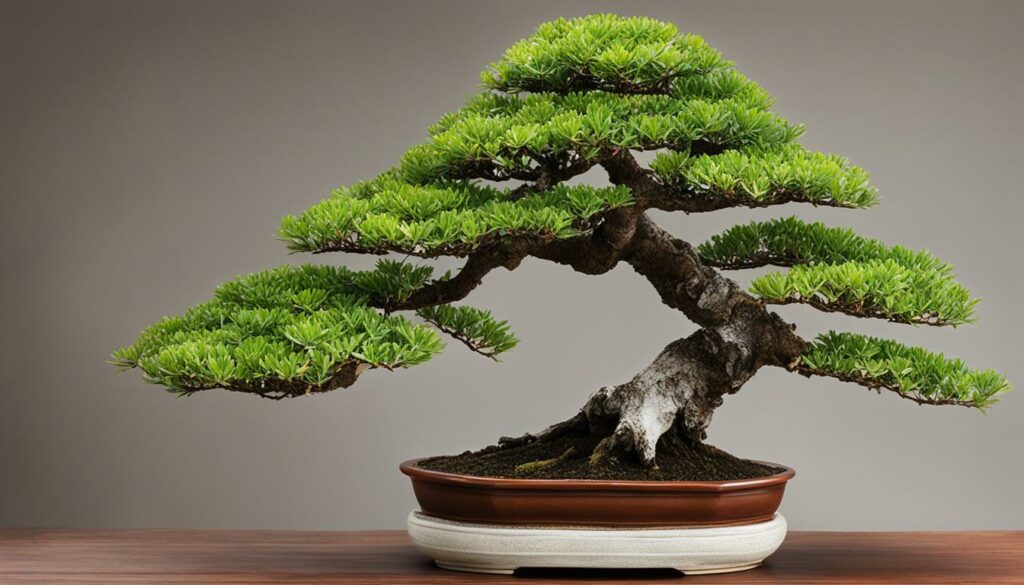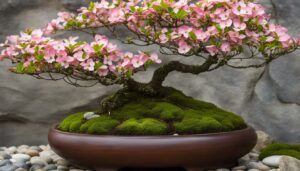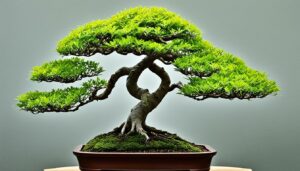Welcome to the world of bonsai trees, where miniature masterpieces are cultivated with care and patience. In this article, we will focus on the Brush Cherry bonsai, scientifically known as Eugenia, and explore the interesting facts about this unique bonsai tree species. From cultivating to displaying and caring for your bonsai, this article will provide you with all the necessary information to start your own journey as a bonsai enthusiast.
Key Takeaways:
- Brush Cherry bonsai is a popular choice among bonsai enthusiasts.
- Proper care and attention are required to grow and maintain a Brush Cherry bonsai.
- Styling techniques such as pruning and wiring can enhance the beauty of your bonsai.
- Be aware of common pests and diseases that may affect your Brush Cherry bonsai.
- Propagation techniques such as seed germination and cutting propagation can help expand your collection.
Introduction to Bonsai Trees
If you are new to the world of bonsai, it is essential to understand the art and technique of cultivating these miniature trees before you dive into the specifics of Brush Cherry bonsai. Dating back to ancient China, bonsai trees have a rich history and are known for their artistic representation of nature in a compact form. By skillfully pruning and shaping trees, bonsai artists create stunning and intricate designs that embody the beauty of nature.
Although they are small, bonsai trees require specialized care to flourish, and each species has its own unique requirements. In this article, we will focus on the Brush Cherry bonsai tree, a popular variety prized for its lush foliage and small fruit. Whether you are a seasoned bonsai enthusiast or a beginner, this guide will provide you with all the necessary knowledge and skills to cultivate your very own Brush Cherry bonsai tree.
To help you get started, take a moment to appreciate the beauty of bonsai trees through this stunning image:
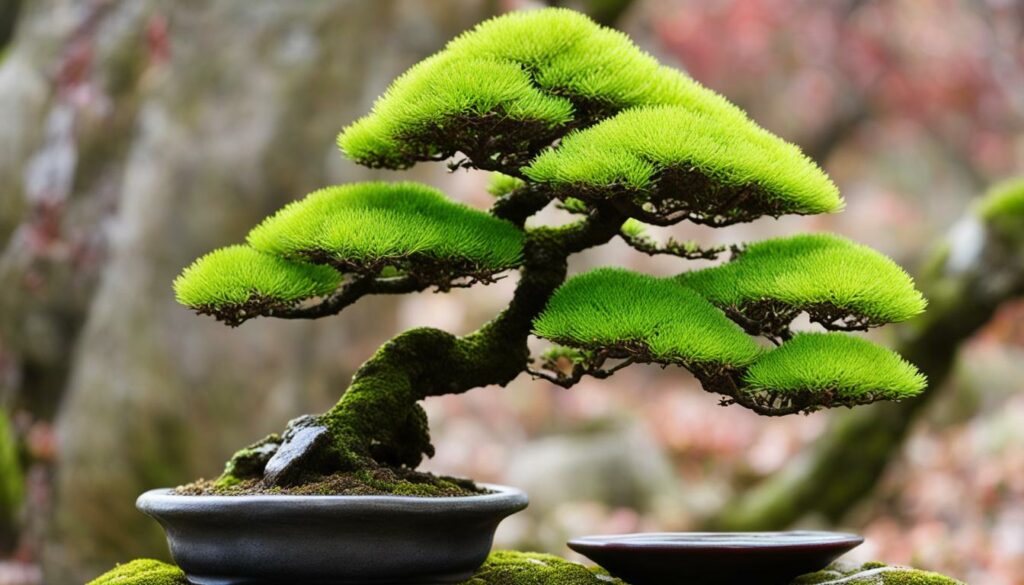
Now that you have a general understanding of the art and beauty of bonsai trees, let’s dive into the specifics of the Brush Cherry bonsai variety.
Brush Cherry – An Overview
When it comes to bonsai tree species, the Brush Cherry, scientifically known as Eugenia, is a popular choice for enthusiasts. This bonsai species is prized for its attractive foliage, small fruit, and its ability to thrive both indoors and outdoors.
The Eugenia bonsai is native to Australia and South Asia, and it is highly valued for its ability to grow into a compact, lush tree with bright green leaves that are oval-shaped. The tree produces small, edible fruits that resemble cherries, adding a unique touch to this bonsai variety.
This small fruit bonsai typically reaches a height of 3-5 feet when mature, and it blooms small, fragrant flowers in the summertime. The Brush Cherry bonsai is highly adaptable to different environments but requires regular trimming to maintain its shape.
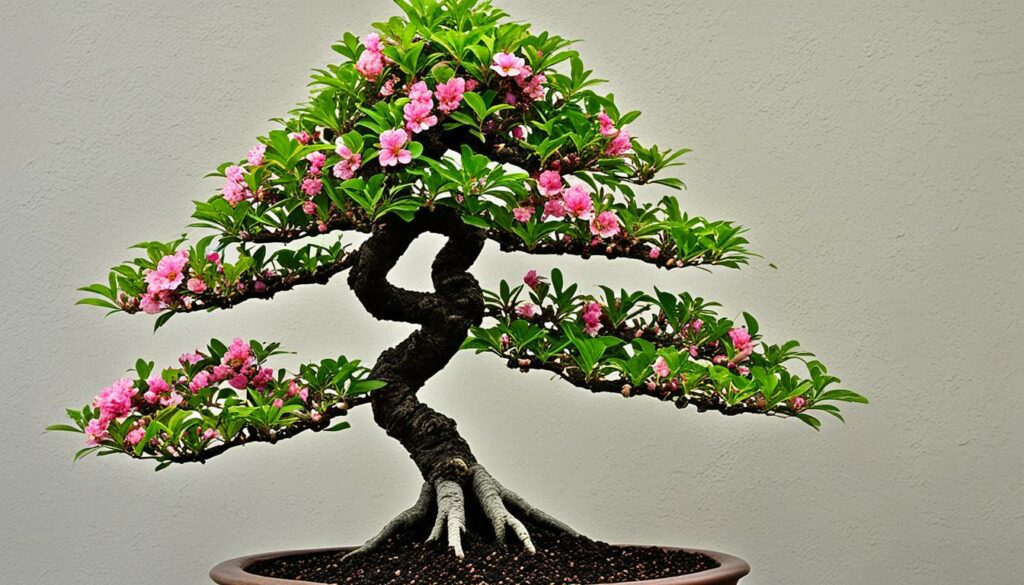
Overall, the Brush Cherry bonsai is a beautiful species that is relatively easy to care for, making it an excellent choice for beginners and experienced enthusiasts alike.
Cultivating a Brush Cherry Bonsai
Cultivating a Brush Cherry bonsai requires patience, care, and attention. With the right approach, you can ensure that your bonsai thrives and flourishes for years to come.
Watering
Water your Brush Cherry bonsai regularly, but avoid over-watering, as this can lead to root rot. Check the soil moisture level by sticking a wooden skewer into the soil, ensuring that it reaches the bottom of the pot. If the skewer comes out clean, it’s time to water the bonsai. If it comes out damp, wait a few days before watering again.
Pruning
Regular pruning is essential to keep your Brush Cherry bonsai healthy and visually appealing. Use sharp, clean scissors to trim any dead or damaged leaves or branches, and to shape the bonsai to your desired form. Prune the bonsai in spring and autumn to encourage new growth.
Positioning
Place your Brush Cherry bonsai in a location that receives bright, indirect sunlight for at least six hours a day. Direct sunlight can scorch the leaves and damage the bonsai. Indoors, position the bonsai near a window that receives adequate sunlight. Outdoors, provide shade during the hottest part of the day to prevent leaf burn.
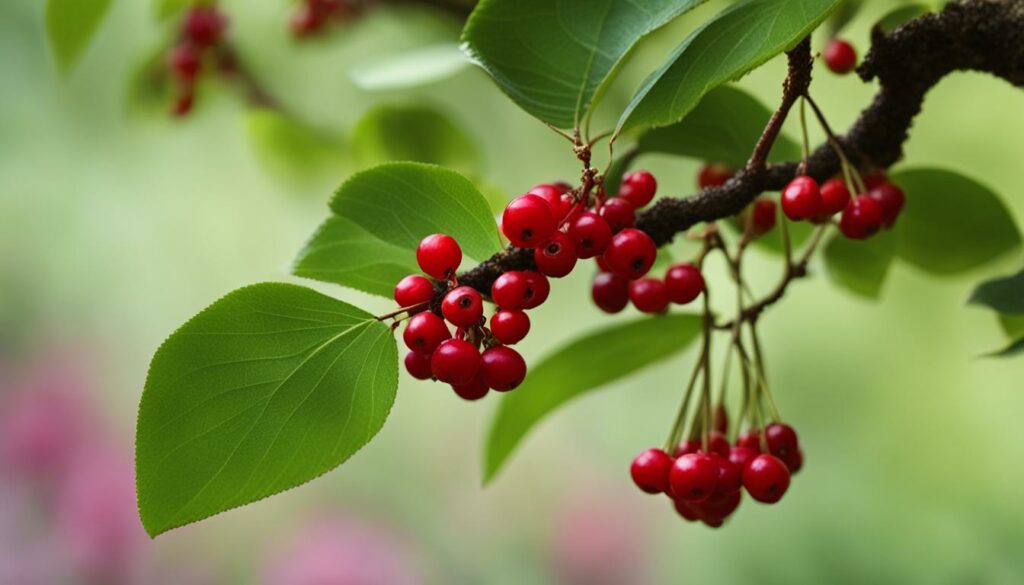
“Proper care and attention are essential to ensure that your Brush Cherry bonsai thrives and flourishes.”
Styling Techniques for Brush Cherry Bonsai
Crafting the ideal appearance of your Brush Cherry bonsai tree is an art form that requires a careful hand and an eye for detail. With a few styling techniques, you can shape and enhance the overall beauty of your bonsai masterpiece.
Pruning
Pruning is a crucial technique in creating the desired look for your Brush Cherry bonsai. Use sharp, clean shears to trim back any unwanted growth and refine the overall shape of your tree. Gradual pruning over time will help create a more natural and appealing appearance.
Wiring
Wiring is equally important to shaping your Brush Cherry bonsai, allowing you to bend and direct the tree’s branches into the desired position. Start by wrapping the wire around the trunk, followed by the branches, making sure not to wrap too tightly to prevent damage or scarring. Over time, the wire can be removed as the branches become more prominent.
Tip: Avoid wiring or pruning during the growing season, which could stunt the growth of your bonsai tree.
Pot Selection
The pot you choose for your Brush Cherry bonsai is just as vital as the tree itself, influencing its overall appearance and enhancing the aesthetics of your display. Pick a pot that is appropriately sized for your tree, with a color and finish that complements the foliage.
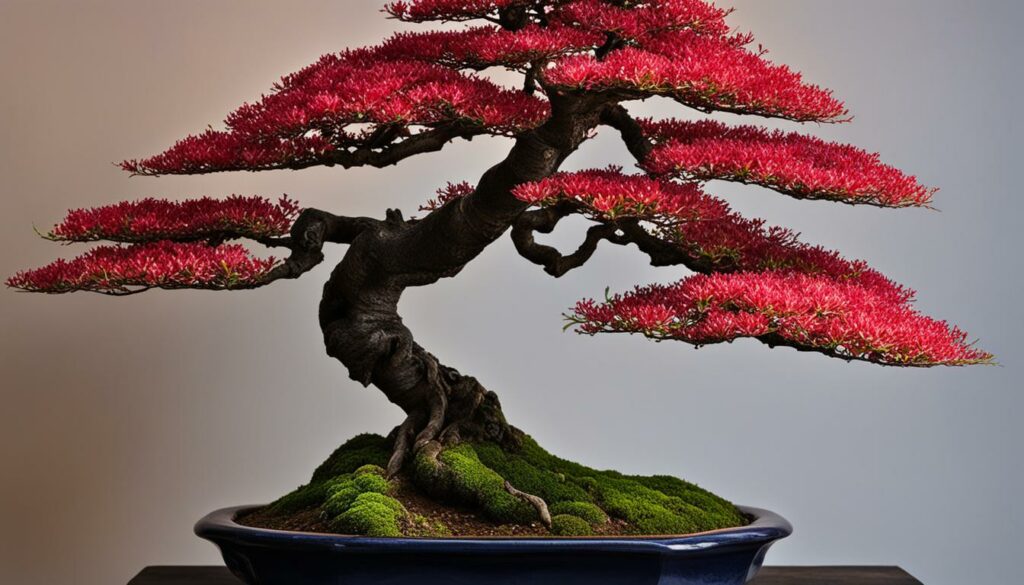
With the right styling techniques, your Brush Cherry bonsai can become a work of art and a beautiful addition to your garden or home.
Displaying Your Brush Cherry Bonsai
After putting all the effort into cultivating and styling your Brush Cherry bonsai, it’s time to display your miniature masterpiece. There are numerous ways to showcase the beauty of your bonsai, depending on your personal style and the environment you wish to create.
If you prefer an indoor setting, place your bonsai near a window with ample sunlight. A windowsill or coffee table can be an ideal spot to highlight the natural beauty of your Brush Cherry bonsai.
For an outdoor garden display, consider placing your bonsai on a pedestal or small table to elevate it and make it a focal point. You can also group your Brush Cherry bonsai together with other bonsai varieties or plants to create a beautiful garden display.
Another popular display option is the traditional Japanese Bonsai stand – “jitta”. The stand helps elevate the bonsai, and it’s a great way to showcase your Brush Cherry bonsai with other decorative elements like stones, moss, and other plants.
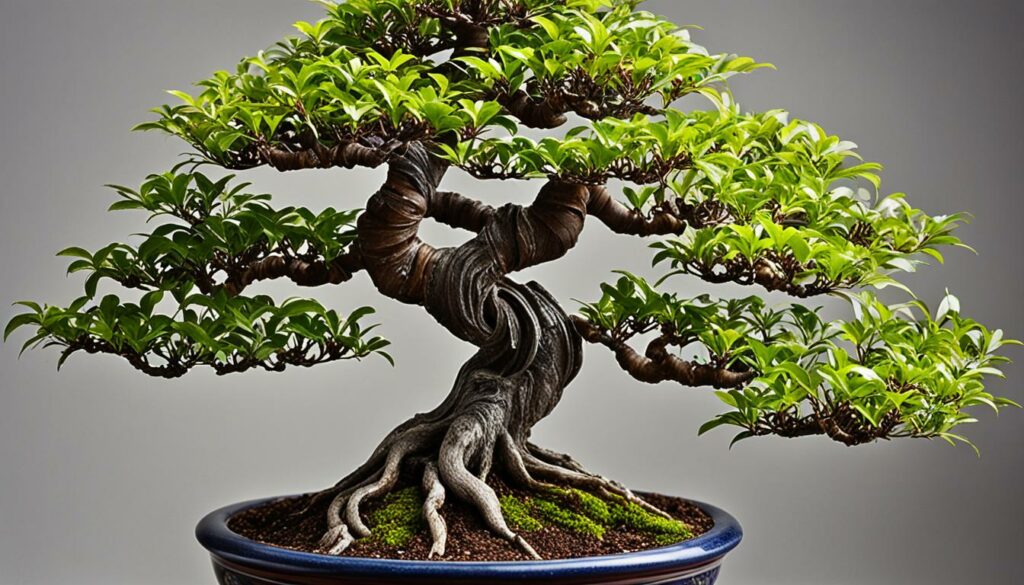
Remember to keep your Brush Cherry bonsai away from extreme temperatures and drafts. Also, avoid placing it in crowded or cluttered spaces.
In summary, displaying your Brush Cherry bonsai is an art form in itself. Choose a display option that highlights the unique beauty of your bonsai, and enjoy the visual delight it brings to your home or garden.
Common Pests and Diseases of Brush Cherry Bonsai
As with any living plant, Brush Cherry bonsai may fall victim to pests and diseases. By understanding the common issues that may arise, you can learn how to prevent and treat them effectively, ensuring the health and longevity of your bonsai.
Scales: One of the most common pests that affect Brush Cherry bonsai is the scale insect. These small, pear-shaped insects suck the sap from the leaves, causing them to turn yellow and eventually fall off. To get rid of scales, you can wipe them off with a damp cloth, prune any heavily infested areas, or use insecticidal soap.
Spider Mites: Another pest that can impact your Brush Cherry bonsai is spider mites. These tiny arachnids feed on the sap of the tree, causing the foliage to develop a yellow or bronze color. To control spider mites, you can increase humidity by misting the leaves or use insecticidal soap.
| Disease | Symptoms | Treatment |
|---|---|---|
| Powdery Mildew | White, powdery coating on leaves and stems | Prune affected areas, improve air circulation, or use fungicides |
| Root Rot | Yellowing leaves, wilting, root decay | Improve drainage, reduce watering, and repot the tree if necessary |
| Anthracnose | Brown or black spots on leaves and branches | Prune affected areas, improve air circulation, or use fungicides |
Brush Cherry bonsai are also susceptible to various diseases such as powdery mildew, root rot, and anthracnose. While prevention is key, it is also crucial to identify and treat any disease as early as possible.
Propagation Techniques for Brush Cherry Bonsai
If you wish to expand your collection of Bonsai Tree Species Brush Cherry, understanding propagation techniques such as seed germination, cutting propagation, and air layering is essential.
Seed Germination
Start by collecting fresh seeds from ripe Brush Cherry fruits of the Eugenia bonsai. Sow the seeds in a well-draining soil mix in a container and water regularly to keep the soil moist. Keep the container in a warm, well-lit spot, and germination should start within a few weeks.
Cutting Propagation
Take semi-hardwood cuttings from the parent plant in spring or summer with a sharp, sterile pair of scissors. Remove the lower leaves and dip the cut end in rooting hormone before planting in a well-draining soil mix. Cover with a plastic bag to create a humid environment, and place the container in a warm, bright location. Roots should begin to develop within a few weeks.
Air Layering
Air layering can take longer than seed germination and cutting propagation but can yield more successful results. Find a healthy, mature branch of the cherry bonsai and scrape off a section of bark. Wrap a ball of moist peat moss in plastic wrap and place it over the exposed area, securing it in place with wire. After a few months, roots will emerge from the section, and the branch can be removed from the parent tree and potted in soil.
TIP: Whichever propagation technique you choose, always ensure to use sterilized equipment, and keep the propagation medium moist but not waterlogged.
Tips for Caring for Brush Cherry Bonsai
Your Brush Cherry bonsai is a living work of art that requires proper care to thrive and flourish. Here are some essential tips to keep in mind:
- Watering: Water your Brush Cherry bonsai only when the topsoil becomes dry. Avoid overwatering or underwatering, both of which can harm the roots.
- Fertilizing: Apply a balanced, water-soluble fertilizer every two weeks during the growing season. This will provide the essential nutrients your bonsai needs to flourish.
- Positioning: Brush Cherry bonsai trees thrive in bright, indirect light. Avoid exposing them to direct sunlight, which can scorch their leaves.
- Pruning: Regular pruning is essential to maintain the shape and health of your Brush Cherry bonsai. Use clean, sharp tools and only prune during the growing season.
- Cleaning: Dust your bonsai regularly to prevent dust buildup on its leaves, which can impede photosynthesis.
Remember, a healthy Brush Cherry bonsai will reward you with stunning foliage and small fruit. With proper care and attention, your bonsai masterpiece can thrive for years to come.
Pro Tip: If you’re unsure about how to care for your Brush Cherry bonsai, consult a local bonsai expert or professional landscaper for guidance.
Conclusion
Congratulations, now you are equipped with the knowledge and skills to cultivate and care for your very own Brush Cherry bonsai! Remember, Brush Cherry bonsai are a species of small fruit bonsai, scientifically known as Eugenia bonsai, or more commonly referred to as cherry bonsai.
By following the techniques and guidelines outlined in this article, you can ensure your bonsai thrives and remains healthy. Whether you choose to display your bonsai indoors or outdoors, the Brush Cherry bonsai is sure to captivate and add natural beauty to any environment.
Don’t forget to familiarize yourself with common pests and diseases, and how to prevent and treat them. Additionally, propagation techniques such as seed germination, cutting propagation, and air layering can help you expand your Brush Cherry bonsai collection or share your passion with others.
Remember to provide proper care, including watering and fertilizing, and to maintain the overall well-being of your bonsai. With patience, dedication, and practice, you can create a miniature masterpiece that represents the artistic representation of nature in a compact form.
FAQ
What is a Brush Cherry bonsai?
A Brush Cherry bonsai is a miniature tree that is cultivated and trained using bonsai techniques. The Brush Cherry, scientifically known as Eugenia, is a popular choice among bonsai enthusiasts due to its attractive foliage and small fruit.
Can I keep a Brush Cherry bonsai indoors?
Yes, Brush Cherry bonsai can be kept both indoors and outdoors. However, they require bright light and proper care to thrive indoors. It is important to ensure that they receive adequate sunlight and proper humidity levels to maintain their health.
How do I water my Brush Cherry bonsai?
It is essential to water your Brush Cherry bonsai regularly but not excessively. The frequency of watering will depend on various factors such as the size of the pot, the climate, and the current season. Monitor the moisture level of the soil and water when it starts to feel slightly dry.
How often should I prune my Brush Cherry bonsai?
Pruning your Brush Cherry bonsai is crucial for maintaining its shape and promoting healthy growth. Regular pruning should be done during spring and early summer to remove unwanted branches and encourage new growth. Additionally, pruning can be done throughout the year to maintain the desired form and size.
Can I style my Brush Cherry bonsai using wiring techniques?
Yes, wiring is a common technique used to shape and style all varieties of bonsai trees, including Brush Cherry bonsai. However, caution should be exercised to avoid damaging the branches. It is advisable to remove the wire after a few months to prevent it from cutting into the bark.
Are there any common pests or diseases that affect Brush Cherry bonsai?
Yes, like any other plant, Brush Cherry bonsai can be susceptible to pests and diseases. Common pests include aphids, scale insects, and spider mites, while diseases such as fungal infections and root rot can also occur. Regular inspection and proper care can help prevent and treat these issues.
How can I propagate my Brush Cherry bonsai?
Propagation of Brush Cherry bonsai can be done through various techniques such as seed germination, cutting propagation, or air layering. Each method has its own requirements and time frame. It is essential to research and follow the specific instructions for each propagation technique.
How do I care for my Brush Cherry bonsai during winter?
During winter, it is crucial to protect your Brush Cherry bonsai from freezing temperatures. If kept outdoors, provide proper insulation by wrapping the pot and branches with horticultural fleece or placing the bonsai in a sheltered location. Indoor bonsai should be placed in a cool room with adequate sunlight.
Can I fertilize my Brush Cherry bonsai?
Yes, fertilizing is an important aspect of bonsai care, including Brush Cherry bonsai. Use a balanced liquid fertilizer during the growing season to provide essential nutrients for healthy growth. However, it is important not to over-fertilize, as this can cause damage to the roots.
